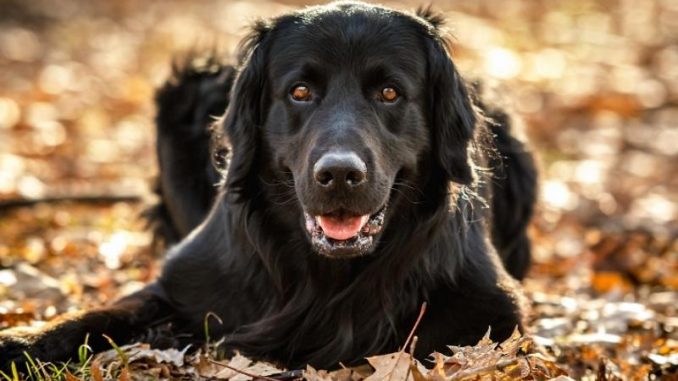
Black Golden Retrievers, a less common variant of the beloved breed, hold a special place in my heart. Their lustrous black coat sets them apart in appearance, but they retain the classic Golden Retriever personality — friendly, intelligent, and incredibly loyal.
I remember the first time I met a Black Golden Retriever. It was a heartwarming experience; despite being in a new environment, this gentle dog greeted everyone with a wagging tail and affectionate nuzzles. As I met more Black Golden Retrievers, they affirmed what I learned on that first day that their adaptability and patience, especially in unfamiliar settings, are truly remarkable.
These dogs have an innate love for outdoor activities, much like my two Labradors. Whether it’s a hike in the woods or a playful day at the beach, Black Golden Retrievers are always eager to be part of any adventure. Their enduring energy and enthusiasm for life make them wonderful companions for active families or individuals.
TABLE OF CONTENTS
- Black Golden Retriever Quick Summary
- Physical Characteristics of the Black Golden Retriever
- Black Golden Retriever Origins
- Black Golden Retriever Personality and Temperament
- Taking Care of a Black Golden Retriever
- Black Golden Retriever Common Health Issues
- Black Golden Retriever Price
- Should You Get a Black Golden Retriever?
- FAQs on Black Golden Retrievers
- A Rare Breed with the Most Striking Appearance
Black Golden Retriever Quick Summary
Physical Characteristics of the Black Golden Retriever
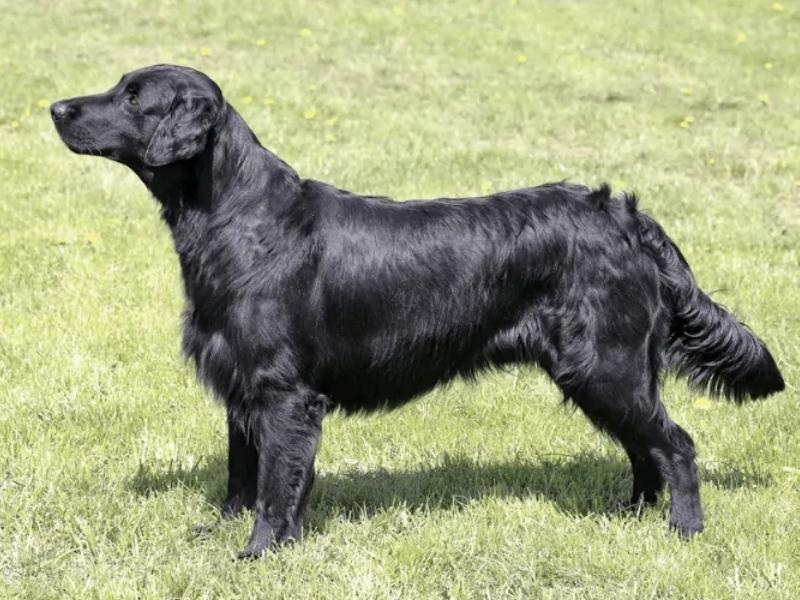
From Adobe Stock
Flat-coated Retrievers, also known as Black Golden Retrievers, are medium to large dogs with long, black, fur that protects them from all weather types. This breed has floppy ears, a long muzzle, and a lean body.
Height and Weight
The Black Golden Retriever is a sturdy and well-proportioned breed. Their height usually ranges from 21 to 24 inches at the shoulder, with males often at the higher end of this scale. Weighing up to 70 pounds, they exhibit a robust, muscular, and graceful build. The females, while slightly smaller, share this strong physique. It’s always a joy to see them move with such agility and strength, whether they’re playing fetch or simply going for a brisk walk.
Coat
The coat of a Black Golden Retriever is indeed a marvel of nature. It’s a dense, water-resistant double coat primarily comes in black or liver, making these dogs stand out in the Golden Retriever family. I’ve often observed that their coat requires regular grooming to maintain its lustrous sheen and to keep it free of mats and tangles.
The coat of a Flat-coated Retriever resembles a black version of the coat of a golden retriever, explaining the nickname of a Black Golden Retriever.
Black Golden Retriever Origins
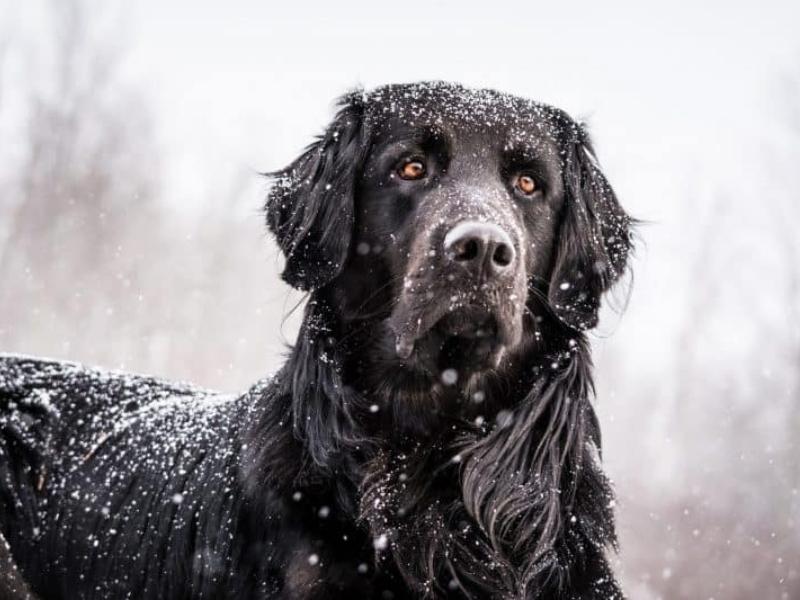
From Adobe Stock
The origins of the Black Golden Retriever are deeply intertwined with the history of the Flat-coated Retriever. My fascination with dog breeds led me to delve into their backgrounds, and I’ve come to appreciate the rich history behind these dogs.
S.E. Shirley, a notable British politician, played a pivotal role in the development of Flat-coated Retrievers. In the 19th Century, when Shirley was most active in dog breeding, the need for a capable, all-round hunting dog was paramount. His vision and dedication led to the development of the Flat-coated Retriever, which combined the best traits of existing Retriever breeds.
H.R. Cooke, the owner of Riverside Kennel, further refined the breed. Under Cooke’s guidance, the Flat-coated Retriever excelled in hunting and began to make a mark in the show ring. His kennel produced many fine examples of the breed, contributing to its growing popularity in the late 19th and early 20th centuries.
During this time, the Flat-coated Retriever, including those with the black coat that would later distinguish the Black Golden Retriever, was a favorite among hunters. Its intelligence, keen sense of smell, and excellent retrieving capabilities made it an ideal companion for hunting expeditions.
However, the onset of the First World War brought significant challenges. The number of Flat-coated Retrievers, like many other breeds, dwindled dramatically. This period also saw the rise in popularity of Labrador Retrievers and Golden Retrievers, which further overshadowed the Flat-coated Retriever.
Today, the Black Golden Retriever, a direct descendant of these early Flat-coated Retrievers, remains a rare sight. Their unique coloration, a throwback to their ancestry, sets them apart. In my time volunteering with animal charities, I’ve had the privilege of encountering a few of these magnificent dogs. Each time, I’m reminded of their storied past and the perseverance of those who have worked to maintain this breed.
Black Golden Retriever Personality and Temperament
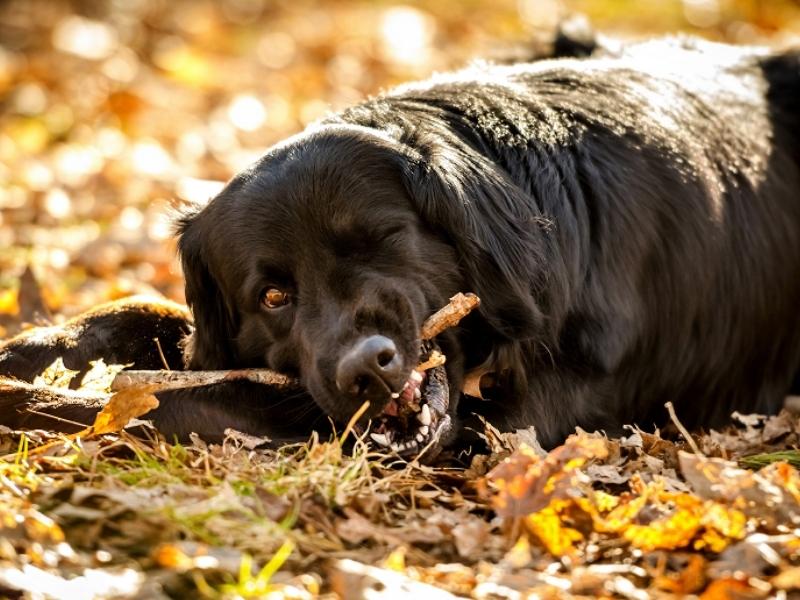
From Adobe Stock
The personality and temperament of Flat-coated Retrievers, including the Black Golden Retriever variant, are truly a delight to witness and experience. Their boundless energy and playful demeanor, which indeed persists well into adulthood, have earned them the affectionate nickname “the Peter Pan of dogs.” Having worked closely with various breeds, I find this youthful spirit particularly endearing in the Flat-coated Retriever.
Their intelligence is immediately noticeable. However, their mischievous streak can sometimes pose a challenge in training. It’s not that they cannot learn; rather, their sassy personality means they often prefer to do things their way. This characteristic requires a patient and consistent training approach. Positive reinforcement works wonders with these dogs. In my interactions, I’ve observed that they respond enthusiastically to rewards and praise, making training sessions both fun and effective.
Flat-coated Retrievers are incredibly sociable. They thrive in environments where they can interact with people of all ages and other dogs. Their outgoing nature makes them excellent family pets, and they often become deeply attached to their human companions. However, due to their high energy levels and need for regular exercise and mental stimulation, they are best suited for active households. In my time volunteering with animal charities, I’ve seen how well these dogs adapt to households that can match their zest for life.
It’s important to note that while these dogs are generally cheerful and resilient, they can be sensitive. Harsh training methods are not suitable for this breed; they respond best to kindness and patience. A gentle approach to training, coupled with consistent, positive reinforcement, will bring out the best in these dogs.
Taking Care of a Black Golden Retriever

From Adobe Stock
Taking care of a Black Golden Retriever is moderately difficult. This breed needs lots of exercises, play, and mental stimulation. Despite being intelligent, the Flat-coated Retriever’s stubbornness can make it difficult to train.
Feeding
In my experience, as a pet parent and through my work in animal welfare, understanding and catering to a dog’s dietary needs is as rewarding as it is essential. Here’s a breakdown of how to best feed this energetic and loving breed.
Nutritional Needs
Black Golden Retrievers require a well-balanced diet rich in proteins, fats, carbohydrates, vitamins, and minerals. Protein is essential for muscle development and maintenance, especially given this breed’s active nature. Fats provide energy and keep their coat healthy. Carbohydrates are vital for energy, while vitamins and minerals support overall health. High-quality commercial dog food usually meets these requirements, but it’s always wise to check the ingredients to ensure your dog gets what they need.
Feeding Schedule
Consistency is key when feeding Black Golden Retrievers. I recommend feeding adult dogs twice a day – once in the morning and once in the evening. Puppies, however, require more frequent feeding, typically three to four times a day, due to their higher energy requirements and smaller stomach capacity. Sticking to a regular feeding schedule helps regulate their digestion and maintains their energy levels throughout the day.
Portion Control
Portion control is crucial for Black Golden Retrievers, a breed prone to obesity if overfed. The right portion depends on their age, size, activity level, and health status. A general guideline is to start with the recommendations provided on the dog food packaging, then adjust as necessary based on your dog’s individual needs. On top of that, keep a close eye on their weight and body condition to determine if their portions need adjusting.
Treats and Snacks
Treats and snacks are great for training and bonding, but moderation is key. They should only constitute about 10% of a Black Golden Retriever’s daily calorie intake to avoid weight gain. I prefer using healthy options like small pieces of cooked chicken or vegetables as treats. It’s important to remember that not all human food is safe for dogs, so stick to dog-safe options.
Special Dietary Considerations
Some Black Golden Retrievers may have specific dietary needs due to health issues like allergies or sensitivities. It’s essential to consult with a vet to identify and cater to these needs. In my years of working with dogs, I’ve seen the impact that a diet tailored to a dog’s specific health requirements can have on their overall wellbeing.
Fresh Water
Access to fresh, clean water is non-negotiable for the health of any dog, including Black Golden Retrievers. They should have water available at all times, and it should be changed regularly to keep it clean. Hydration is especially important for active breeds like this one. In my household, I make sure my dogs’ water bowls are always filled and clean, as this is as crucial as their diet.
Grooming Needs
Here’s a detailed guide on how to keep these beautiful dogs well-groomed.
Coat Care
Black Golden Retrievers have a thick, water-resistant double coat that requires regular grooming. I recommend brushing their coat at least two to three times a week to prevent matting and to remove loose hair and debris. During shedding seasons, usually in the spring and fall, daily brushing might be necessary to manage the increased shedding. A slicker brush or an undercoat rake can be particularly effective for their coat type.
Bathing
Bathing a Black Golden Retriever every 6-8 weeks is generally sufficient unless they get particularly dirty. Further, over-bathing can strip their coat of natural oils, so it’s important to use a mild, dog-specific shampoo. I always ensure that the water is warm (not hot) and thoroughly rinse off all shampoo to prevent skin irritation. Post-bath, drying their coat thoroughly is crucial, especially in colder weather, to prevent chilling and matting of their undercoat.
Nail Trimming
Regular nail trimming is essential for their comfort and health. I usually trim my dogs’ nails every 3-4 weeks. If you can hear their nails clicking on the floor, it’s a sign that they are too long. Using a proper dog nail clipper and being cautious not to cut into the quick (the blood vessel in the nail) is important. If you’re unsure about doing it yourself, a professional groomer can help.
Ear Care
Their floppy ears can trap moisture and lead to infections, so regular ear checks and cleaning are crucial. Clean them every few weeks with a gentle, vet-approved ear cleaner, especially after baths or swimming. Such regular care can prevent ear infections.
Dental Hygiene
Dental health is often overlooked but is vital. Brushing their teeth several times a week with dog-specific toothpaste can help prevent tartar buildup and dental issues. Additionally, dental chews and toys can supplement their dental care routine.
Eye Care
Regularly checking their eyes for any signs of irritation or discharge is important. You can wipe the area around their eyes with a soft, damp cloth to keep them clean and infection-free.
Training and Exercise

From Adobe Stock
Training and exercise are crucial elements in the care of Black Golden Retrievers. These aspects not only ensure a well-behaved dog but also contribute significantly to their physical and mental well-being.
Training
Black Golden Retrievers are known for their sensitivity, which makes positive reinforcement the most effective training method. In my experience working with various dog breeds, rewarding good behavior with treats, praise, or play has always yielded better results compared to harsh methods. Starting training from a young age is essential for socialization. Introducing them to different people, environments, and other dogs helps develop a well-rounded and sociable character.
Training should also focus on basic obedience and can include fun tricks to keep them engaged. It’s important to be patient and consistent; this breed may sometimes show a stubborn streak, but with gentle guidance, they learn quickly and willingly.
Exercise
An adult Black Golden Retriever needs about 90 minutes of exercise daily. This exercise can be divided into walks, play sessions, or runs. It’s crucial to balance their physical activity to maintain their health without causing strain, especially in puppies. For instance, a four-month-old puppy should only have about 20 minutes of exercise per day to prevent joint problems.
Living in a suburban or rural environment with access to outdoor spaces is ideal for this breed. They thrive in settings where they can expend their energy and explore.
Mental Stimulation
Given their high intelligence, Black Golden Retrievers require ample mental stimulation. This can be provided through interactive play, training sessions, and puzzle toys. These activities keep their mind engaged and prevent boredom, which can lead to destructive behavior.
I’ve seen the benefits of mental stimulation in promoting a dog’s overall well-being. Teaching them new tricks, playing fetch, or even simple games like hide and seek with treats can significantly enhance their cognitive abilities. Hence, ensure they have a variety of toys and challenges.
Black Golden Retriever Common Health Issues
Maintaining the health of Black Golden Retrievers requires an understanding of the breed-specific health issues they may face. Here’s a detailed look at some of the health issues they are prone to, along with their symptoms, causes, and treatment options.
Hip Dysplasia
Hip dysplasia is a common condition in larger breeds like Black Golden Retrievers. It’s a genetic deformity where the hip joint doesn’t fit together perfectly, leading to pain and mobility issues. Symptoms often include difficulty in rising, reluctance to run or jump, and a noticeable limp. I find that asking the breeder about the parents’ health history is crucial to gauge the risk. Treatment ranges from lifestyle adjustments and physiotherapy to manage mild cases, to surgical interventions for severe cases. It’s also important to catch hip dysplasia early.
Malignant Histiocytosis
Malignant Histiocytosis is a serious concern in Black Golden Retrievers. This rare form of cancer affects the histiocytes – a type of white blood cell. Symptoms can include lethargy, loss of appetite, and unexplained weight loss. Due to the aggressive nature of malignant histiocytosis, early detection is vital. Treatment options include surgery, chemotherapy, and radiotherapy. However, the prognosis is often poor.
Lymphosarcoma
Lymphosarcoma, a common type of cancer in dogs, can affect various parts of the body, including lymph nodes, spleen, liver, and gastrointestinal tract. Symptoms may vary depending on the cancer’s location but can include swelling in lymph nodes, weight loss, vomiting, and diarrhea. Chemotherapy is the primary treatment, and the response can be quite promising. Early treatment can significantly improve outcomes for dogs with lymphosarcoma.
Black Golden Retriever Price
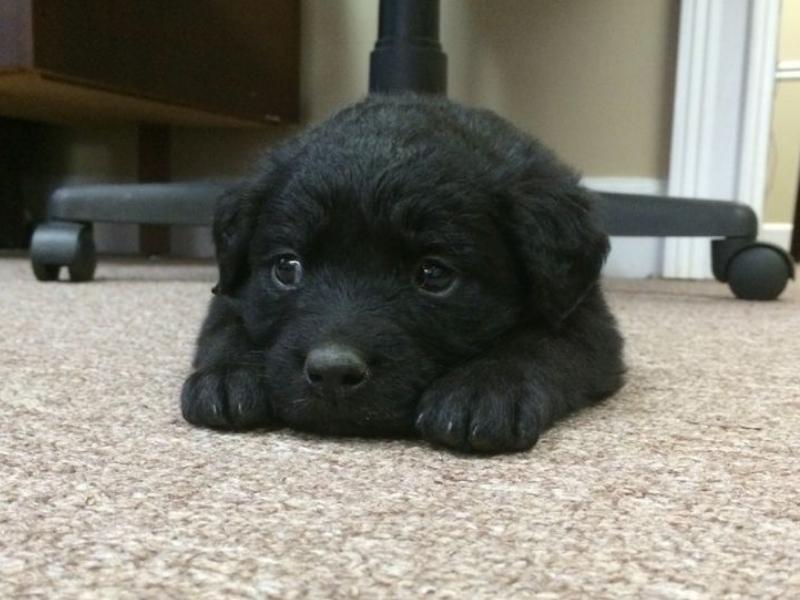
From Adobe Stock
How Much is a Black Golden Retriever?
A Black Golden Retriever is $1,500 to $3,000. Puppies are more expensive than adults, and adopting is significantly cheaper than buying from a breeder. I did a quick search and found that adoption fees are typically between $200 and $500, although there are very few flat-coated Retrievers in adoption centers.
How Much Does it Cost to Raise a Black Golden Retriever?
For food, grooming, and healthcare costs, expect to pay $100–$200 per month to raise an average Black Golden Retriever. You’ll typically pay more in the first year of owning a Flat-coated Retriever because you’ll need to buy first-time vaccines, toys, dog food, a dog bed, a crate, and any other necessary equipment.
As the retriever’s healthcare needs increase in its later years, the costs will increase. Depending on lifestyle, Black Golden Retriever owners may need to factor in costs such as a dog-sitter or dog-walker.
Should You Get a Black Golden Retriever?
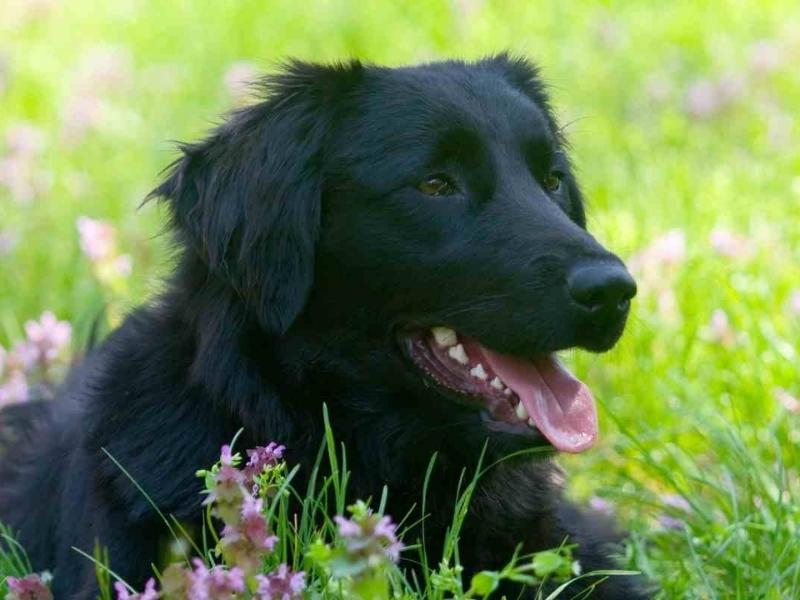
From Adobe Stock
Black Golden Retrievers are loveable, affectionate, and friendly dogs with tons of energy. However, because of this breed’s mental and physical stimulation needs, and stubborn streak, owning a flat-coated retriever is not recommended for first-time dog owners.
Black Golden Retrievers are Suitable for:
Black Golden Retrievers are gentle dogs that are rarely aggressive, so they’re suitable for families with children. However, their exuberant personality can be overwhelming for very young children, so these dogs are more suitable for older children.
If you have room for a medium to large-sized dog and are ready to give this breed lots of attention and exercise, the Black Golden Retriever can be a suitable dog for you. This breed is suitable for families with previous dog-training experience who know how to cope with stubborn breeds.
Black Golden Retrievers are NOT Suitable for:
Flat-coated Retrievers are not suitable for people with little time to walk or play with a dog. This breed is sociable and loves to be with its owners, so it’s unsuitable for people who spend lots of time away from home.
Because Black Golden Retrievers are relatively large and need plenty of exercise, they’re not well-suited to apartment living or homes without outdoor space.
FAQs on Black Golden Retrievers
What is the lifespan of a Black Golden Retriever?
Black Golden Retrievers typically have a lifespan of about 10 to 12 years. Like any breed, their longevity can be influenced by genetics, diet, exercise, and overall care. Regular veterinary check-ups and a healthy lifestyle are essential in ensuring they live a full and happy life.
Are Black Golden Retrievers good family pets?
Yes, Black Golden Retrievers are excellent family pets. They are known for their friendly, outgoing, and affectionate nature. Their intelligence and playful demeanor make them great companions for children. However, it’s important to supervise interactions between young children and dogs to ensure safety for both.
How much exercise does a Black Golden Retriever need?
Black Golden Retrievers are active dogs and require about 60 to 90 minutes of exercise daily. This should include walks, playtime, and other physical activities. Puppies and younger dogs might have even more energy and may require additional exercise and playtime.
Do Black Golden Retrievers require a lot of grooming?
Yes, Black Golden Retrievers require regular grooming. Their thick, water-resistant double coat needs brushing several times a week to prevent matting and remove loose fur. They also need regular baths, nail trims, ear cleaning, and dental care to maintain their overall health and appearance.
Are Black Golden Retrievers easy to train?
Black Golden Retrievers are generally easy to train due to their intelligence and eagerness to please. However, their training should be based on positive reinforcement techniques. Consistency and patience are key, as they can sometimes be a bit stubborn.
Can Black Golden Retrievers live in apartments?
While Black Golden Retrievers can adapt to apartment living, they do best in homes with more space, like a house with a yard. Due to their size and energy levels, they need ample space to move around and exercise. Regular outdoor exercise is crucial if living in an apartment.
What health issues are Black Golden Retrievers prone to?
Black Golden Retrievers are prone to certain health issues like hip dysplasia, malignant histiocytosis, and lymphosarcoma. Regular veterinary check-ups and a healthy lifestyle can help in early detection and management of these conditions.
Are Black Golden Retrievers rare?
Yes, Black Golden Retrievers are a rarer variant of the Golden Retriever breed. Their unique coat color is due to a specific genetic variation, making them less common than the traditional golden-colored retrievers.
A Rare Breed with the Most Striking Appearance
Choosing a Black Golden Retriever is a decision I see as both rewarding and demanding. Their affectionate nature and playful spirit make them a joy in family settings. They’re intelligent and trainable, which can be a delightful experience for an engaged pet owner.
However, their need for regular, vigorous exercise means they’re best suited for active lifestyles. Grooming them is a regular commitment due to their thick coat, but a great bonding moment. Health-wise, they do have some vulnerabilities, such as hip dysplasia and certain cancers, which reminds me of the importance of regular vet visits and attentive care. In essence, if you’re ready for the active, engaging, and caring journey that comes with them, a Black Golden Retriever could be a heartwarming addition to your life.

Be the first to comment